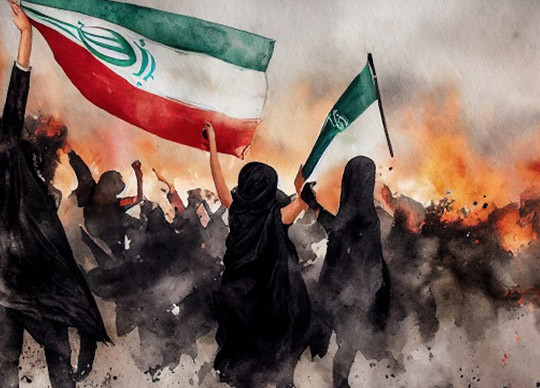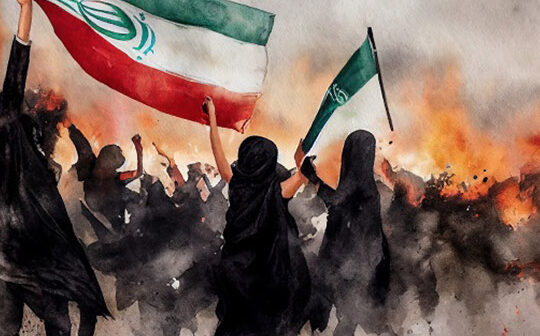
By Dr. Amin Tarzi.
BESA Center Perspectives Paper No. 2,177, February 2, 2023.
Republished with permission from BESA.
When popular protests began in Iran in mid-September 2022, the regime of the Islamic Republic initially tried to portray them as sporadic disturbances by misguided individuals who were supported and encouraged by the United States, Israel, Saudi Arabia, and a few European countries.
As the protests intensified and began to spread throughout the country, the regime subtly yet systematically shifted the blame onto two non-Persian, predominantly Sunni regions of the country: Kurdistan in the northwest and Sistan and Baluchistan in the southeast.
While the protests have lost some of their intensity, the regime’s object is to taint the message of popular protest movements and muddy their message by linking them to separatist aspirations in those regions and foreign meddling.
I have discussed elsewhere why the current protests in Iran have an objective that, if sustained and coordinated, could begin to resemble the protests of 1978-79 that ended the monarchical system in Iran. Here I will focus on the centrality of the protests’ narrative to their success.
The Message of the Protest Movement
Mass public protests in Iran are nothing new. At various times, the Islamic Republic has tried to present different faces of the regime to the public, occasionally offering a semblance of more openness or public participation.
However, the protests that began in September 2022 are not calling for cosmetic changes. They are calling for the end of the regime, which has lost legitimacy in the eyes of the majority of the Iranian people — particularly those of the post-revolution generations.
The authorities in Tehran are of course well aware of the protesters’ goal. In response, they have targeted — using both rhetorical weapons and intensified brutality — two predominantly non-Shia and non-Persian regions of the country in an attempt to link the protests to the Kurdish and Baluchi insurrections and separatist movements. Their intention is to break the protest movement’s momentum and muddy its anti-regime message.
The current protests were triggered by the death of a young woman, Mahsa Amini, in police custody. The popular uprisings have much deeper roots, however, than concern over the violation of women’s rights or other civil liberties.
The chant heard in the streets of Iran since September is “woman, life, and freedom”.
The inclusion of the latter two words is significant. Limitations on women’s rights have been a hallmark of the Islamic Republic since its inception 43 years ago, and while this has long been a source of tension, it has not historically been enough to mobilize large swaths of the population against the regime.
This time is different. The protesters are now making a connection between the experience of Iranian women and the lives and freedom of all Iranians.
They are sending a strong message that the Iranian regime restricts life and freedom for the entire population and is therefore rejected by it outright.
Beware the Official Narrative
Despite the durability and global reach of the protest movement, there are no known leaders around whom the protesters can coalesce.
Nor do the protesters appear to have a set agenda for moving forward. It thus appears likely that should the Islamic Republic further intensify its brutality against the Kurdish and Baluchi-dominated regions of the country, the protests will take on a more ethno-sectarian dimension.
Should this occur, the regime will most likely expand its targeting of Baluchi separatists into Afghanistan or Pakistan and of Kurdish nationalists in Iraq.
The regime would take the opportunity to portray the protest movement as an attempt by minorities, often labeled as “terrorists”, with the support and encouragement — if not the explicit direction — of the United States, Israel, Saudi Arabia, and a few European countries, to dismember Iran.
The regime would thus purport to be the defender of the nation against its would-be destroyers.
Ever since the early days of Islamist rule in Iran, there have been events—including but not limited to the Iran-Iraq War (1980-88), the death of Khomeini (1989), and the Green Movement (2009-10)—that have led Iran watchers to predict the regime’s imminent demise. It has always managed to survive.
It has employed a diversified strategy of force and intimidation, occasional attempts to create the impression of a willingness to expand civil rights through the façade of popular choice in elections, and the forging of international deals through nuclear extortion to change narratives and gain international acceptability.
The regime is now trying to divide and ultimately destroy the current movement by reorienting the narrative away from regime survival and toward national survival.
Moving Forward
A unified, law-abiding Iran would not only change the geopolitical landscape of the Middle East and hydrocarbon politics but would also have a profound impact on Great Power competition between the United States and China as well as on Russia’s disruptive role in international affairs.
As such, supporting the fundamental message of the current protest movement—i.e., the Iranian people’s struggle for freedom from tyranny—rather than the irredentist voices will foster conditions for an independent Iran as a center for regional stability.
More fundamentally, it would curtail attempts by the Islamic Republic to twist the narrative from one of a threat to the regime to one of a threat to the country itself.
That said, the leadership vacuum and lack of unified purpose of the protest movement are vulnerabilities that leave the movement open to sabotage by more organized irredentist groups with existing agendas and powerful leaders.
Perhaps it is anxiety over regionalism or widespread lawlessness that has kept key elements of Iranian society, including merchants and workers, from organizing widespread support for the protesters.
In sum: If the current protest movement manages to maintain its fundamental message, despite regime efforts through violence and terror to silence it and end its presence on the streets, the legitimacy of the Islamic Republic will become irreparable.
The call by the European Union Parliament on January 19, 2023 for more sanctions against the Iranian regime and listing of the IRGC to the EU terrorist list, while not binding, is an indication of broad support for the fundamental narrative of the protests in Iran.
However, should the Islamist system manage to reframe the message into one of the survival of the nation, the regime will not only be able to crush the uprisings and gain support among segments of Iranian society, but also reestablish its legitimacy by showcasing itself as the guardian of Iran’s national unity.
The narrative of woman, life, and freedom must be maintained and not altered.
Dr. Amin Tarzi is the Director of Middle East Studies (Krulak Center for Innovation & Future Warfare) at Maine Corps University. The opinions and conclusions expressed herein are those of the individual author and do not necessarily represent the view of either the Marine Corps University or any other U.S. governmental agency. Any reference to this publication should include the foregoing statement.






